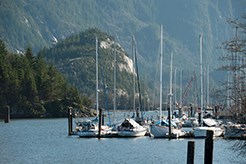Soon Squamish residents will have a chance to have their say on a long-awaited Squamish marine strategy.
After five years, phase one of a unique-to-Squamish Marine Strategy is now complete, and soon community and stakeholder engagement can begin, according to a report presented to the community development standing committee on March 3.
Mayor Patricia Heintzman said a Squamish marine strategy is important because it is a vision for the waterways to which the public finally has access.
“When I first moved to Squamish, the first couple of years I never got to the oceanfront,” she said “you couldn’t get to it from downtown. It was all industrial. All the Mamquam Blind Channel was log sorts, essentially. You couldn’t get to the water and so people want to get to the water, and we are slowly realizing that. The trick is marrying that with industrial access to the water too, because that is important.”
Phase one of the strategy involved understanding Squamish’s marine issues and how to get greater jurisdiction of the waterways at the local level. Phase two will involve getting direction from council, planning and seeking public input.
Since 2011, district staff has been looking at ways to address Squamish marine issues such as unauthorized mooring, derelict vessels, people living aboard their vessels and ship pollution, according to Neil Plumb, real estate manager for the district.
The district is also looking for ways to revitalize tourist and recreational access and redevelopment of the waterfront, the report states.
Many elements of the marine strategy have yet to be confirmed, including its boundaries. The unconfirmed draft boundary includes the Squamish River Estuary, the wildlife Management Area, the Mamquam Blind Channel, Cattermole Slough, and the Howe Sound Basin to the district boundary, according to the marine strategy report.
The issue of who is responsible for what, in and on the water, is a complicated one with the province, the federal government and the district.
“In our area here we’ve got the feds, who typically control what goes on on top of the water and the movement of vessels and the anchoring of vessels… the [provincial] Crown owns the underwater seabed,” said Plumb.
Because it isn’t likely the federal government will hand over any of its authority in regards to the issues on the top of the water, staff has recommended the district pursue a Crown lease.
“What would happen there is we would go to the Crown and get a recreational water lease,” Plumb said. “[Then] the district gets a little bit of authority, because we [would now] have proprietary interest… which is a legal right to manage this area through a lease.”
The district would then be able to deal with situations such as the Spudnik, and vessels that anchor for extended periods of time. There is a free right to navigate anywhere on water, but vessels can’t park on the water for a long term, Plumb said.
As part of the strategy and in partnership with the Squamish Streamkeepers Society, the district will be removing some pilings, which will help control nuisance mooring. Environmentally responsible pilings – the current pilings are toxic and left over from log sorts – will be put back in places where the district wants to see moorage.
The district will also be talking with the RCMP about their Coastal Watch Program and with the Coast Guard regarding ways the district can support reporting and enforcing locally, Plumb said.
Working with the Squamish Nation on the strategy will also be key in the coming months, Heintzman said.
Plumb said the waterfront area of Squamish is in transition and so a blank slate in a lot of ways.
“And so it is an opportunity to develop a strategy that really takes advantage of the opportunity,” he said.
Public engagement will begin in the coming months.
Go to squamish.ca for updates on opportunities to comment.



